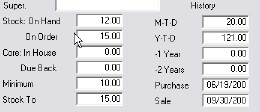Stock On Hand
This is the actual number of parts currently on the shelf, or in storage. ** HINT ** When first setting up the system, you will be entering parts which may be sold before the job is complete. We suggest you use the stock counts from the shelf. When complete, run the inventory report, perform a physical count, and calculate the differences. You will be able to then use the Input option to add, or decrease, your actual count.

Stock On Hand and On Order
Whenever parts are first added to the system, it is necessary to specify the current stock on hand.
Always leave the On Order field at 0, because this is manipulated by the Purchase Order system. When parts are ordered using a P/O, the On Order total will increase by the amount specified. When parts are input into stock, that have been on a P/O, the number will be decreased, and the Stock On Hand will be increased.
When parts are added to a workorder, the stock is decreased by the quantity used. However, if that number is adjusted through editing, the Stock On Hand will not be adjusted
appropriately.
*** ERROR WARNING *** Some people tend to not use the stock input program - and simply adjust the Stock On Hand value whenever parts are received. This is not recommended because other values (ie. average cost) are not calculated properly. Although you can realistically perform this operation, the result will be a failure to really see the proper inventory statistics.
Core In House and Due Back
Generally, the Core In House and the Core Due Back fields will never be touched. On initial setup, if cores have been tracked manually, it will be best to continue tracking the outstanding cores by hand until they have been fully "processed." The The Auto Shop Writer system will track the cores with workorder processing. The Core In House total are used core, waiting to be returned to the vendor. The unsold core is the same count as the Stock On Hand. The Due Back field is the count of core which are currently in the hands of clients, usually as the result of a counter sale, and they are due to be returned.
Setting Minimum, and Stocking, Levels
The Minimum is that stock level below which you wish to reorder new parts. This figure may be calculated by the following formula:
(Sales/day x days to restock) x safety factor
If you sell 2 framagadgets each day, it takes 5 days to receive an order, and you want a 20% safety factor, you would have 2 x 5 x 1.2, or a minimum of 12. Using your averages, this means that you will actually be able to function for 6 days waiting for your order. Of course, no formula will be totally dependable, and you could run low, or overstock. As you calculate your minimums, you may realize that some adjustments will be necessary. These can be made manually at any time.
The Stocking Level works on the same principle. You would use the formula:
((Sales/day x restocking interval) x safety factor) + minimum
If you stock every 10 working days, and you average 2 sales per day, with a minimum of 12, and a safety factor of .2, you would calculate the Stocking Level as (2 x 10 x 1.2) + 12, which equals 36. These two figures will keep your stock under control.
Sales History: Y-T-D, M-T-D and Past Years
The Auto Shop Writer automatically totals all parts sales, and maintains a history count for the inventory items. The Month Chart, Month To Date and Year To Date counters are advanced with every sale. The -1 year, and -2 years totals are preserved when a year end closing is performed.
The Month To Date field displays the total sales for the current month. The chart shows the totals for each month of the fiscal year.
When entering parts for the first time, totals can be entered in these fields if they are known. Otherwise, simply let the system do the counting. The program also tracks the dates of last sale, and last purchase. This is especially useful when monitor information during parts ordering.
Obviously, if you hit the minimum on a part, but it hasn't sold for a month, and availability is good, it is probably time to readjust the minimum. Intelligent decisions will be at hand by watching these dates during order processing.
Date of Last Purchase, Sale
The system will automatically track when you last purchased an individual part, and when you last sold one. You do not need to enter any values in these fields.
You may find the information valuable when you browse parts, but it is also possible to run reports based on these dates, and to adjust your stocking patterns accordingly.
Monthly Totals

The system will automatically accumulate the totals for each part sold in the appropriate month. This chart is interactive with the parts application routine that places items on workorders, and is considered "live" processing.
Stocking vs. Non-Stocking Parts
The advantage of this inventory system is that it tracks all parts used including those that do not reside in inventory. Consequently it is very easy to track non-stocking items of quantity, seasonal parts, and lost sales. The system will automatically place non-stocking parts into inventory when first used, and then update the data as appropriate.
Vendors

When you purchase a part from a vendor, you will want to add them to the list. You must use the proper A/P account number and not codes of your own development. These codes help process automatic ordering, and give you a quick reference when needing to buy specific parts or replace stock. You may use the ![]() button to open a lookup in Accounts Payable.
button to open a lookup in Accounts Payable.